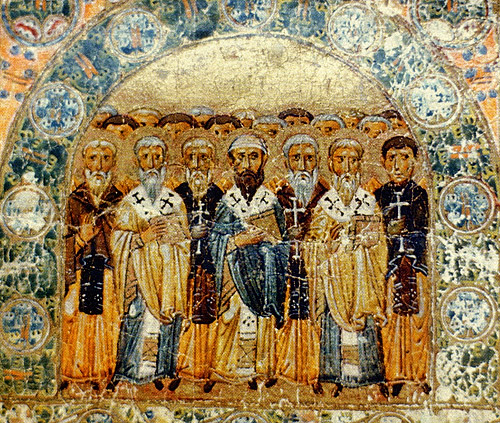
Great Church
The term "Great Church" (Latin: ecclesia magna) is used in the historiography of early Christianity to mean the period of about 180 to 313, between that of primitive Christianity and that of the legalization of the Christian religion in the Roman Empire, corresponding closely to what is called the Ante-Nicene Period. "It has rightly been called the period of the Great Church, in view of its numerical growth, its constitutional development and its intense theological activity."[1]
For the "Great Church of Christ" in Byzantine usage, see Ecumenical Patriarchate of Constantinople. For other uses, see Great Church (disambiguation).
The Great Church, also called the catholic (i.e., universal) Church,[2] has been defined also as meaning "the Church as defended by such as Ignatius of Antioch, Irenaeus of Lyons, Cyprian of Carthage, and Origen of Alexandria and characterized as possessing a single teaching and communion over and against the division of the sects, e.g., gnosticism, and the heresies".[3]
By the beginning of the fourth century, the Great Church already formed about 15% of the population of the Roman Empire and was ready, both numerically and structurally, for its role as the church of the empire, becoming the state religion of the Roman Empire in 380.[4]
Roger F. Olson says: "According to the Roman Catholic account of the history of Christian theology, the Great Church catholic and orthodox lived on from the apostles to today in the West and all bishops that remained in fellowship with the bishop of Rome have constituted its hierarchy";[5] or, as the Catholic Church itself has expressed it, "This Church constituted and organized in the world as a society, subsists in the Catholic Church, which is governed by the successor of Peter and by the Bishops in communion with him, although many elements of sanctification and of truth are found outside of its visible structure."[6] Thus, the Roman Catholic Church identifies itself as the continuation of the Great Church, which in turn was the same as the early Church founded by Jesus Christ. Because of this, it identifies itself as the "one true church".
The unbroken continuity of the Great Church is affirmed also by the Eastern Orthodox Church: "Orthodoxy regards the Great Church in antiquity (for most of the first millennium) as comprising, on one side, the Eastern Orthodox world (the Byzantine patriarchates presided over by the hierarch of the Church of Constantinople together with the Slavic Orthodox churches); and, on the other side, the Western Catholic Church, presided over by the hierarch of the Church of Rome."[7]
Historical references[edit]
In Contra Celsum 5.59 and 5.61 the Church Father Origen mentions Celsus' late 2nd century use of the terms "church of the multitudes" or "great church" to refer to the emerging consensus traditions among Christians at the time, as Christianity was taking shape.[12][13]
In the 4th century, as Saint Augustine commented on Psalm XXII, he interpreted the term to mean the whole world, writing: "The great Church, Brethren, what is it? Is a scanty portion of the earth the great Church? The great Church means the whole world."[14] Augustine continued to expound on how various churches all considered themselves "the great Church," but that only the whole world could be seen as the great Church.[14]